First-Time Flyer Guide | 29 Airport and Airplane Tips for a Smooth Journey

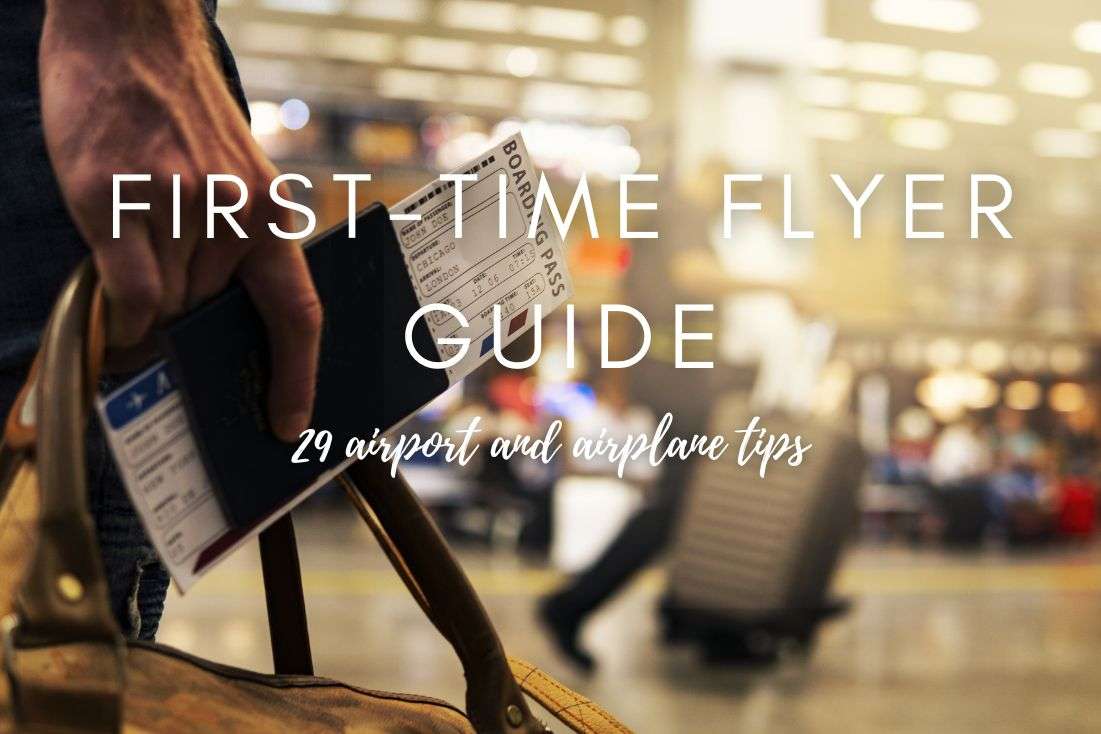
If you’re getting ready to fly for the first time, welcome. Big step, huh? More like a huge leap… 11 km (7 mi) into the sky! I understand that you’re feeling nervous, but don’t worry, I’ve got you covered with a guide to everything you need to know to be ready for your first time on an airplane.
I’ve seen other first-time flyer guides—they cover the general aspects of flying, but leave out the little things that really leave you hesitating. My guide is better, it omits nothing and prepares you for everything.
I’m here with all the slightly sarcastic but ultimately helpful advice you need to navigate the airport, security, boarding, and everything else that makes first-time flyers sweat, on the plane and off. I won’t promise to magically erase all your nerves but knowing exactly what to expect does help—because knowledge is power. By the time you’re done reading this guide, you’ll be flying like an Avenger.
Expect essential first-time flyer tips and things you didn’t know, answers to your biggest questions, and yes—even an explanation of why you should never drink coffee on a plane (but will anyway).

Dare to take your first flight to discover the world! For example, Kenzo Ji in Nagano, Japan
What does a first-time flyer need to know?
I’ll hold your hand your first time at the airport and your first time on the airplane. Heck, I’ll even help you book a plane ticket and pack your bags! But first, let’s take a quick look at the top things no one tells you about flying for the first time:
- This isn’t the 80s or Home Alone. Airports are made to be fool-proof. Remember that millions of people of varying intelligence figure it out every day (10–12 million, to be exact). You will not board the wrong plane, and you won’t accidentally end up in another country without realizing it, they just won’t let you. It’s not rocket science.
- Yes, your seat will probably suck unless you pay extra. The “free” seat selection usually sticks you in the middle seat and not next to your travel companion, so pay for your seat reservations when you buy your plane ticket.
- Bring an empty water bottle—but don’t fill it up until after security. You don’t want to be that person chugging a liter of water in line while everyone waits for you to move on forward.
- Planes are chillier than you think. Think cold, dry air for hours. The air conditioning is brutal, and airplane blankets are thin. Bring a hoodie (and moisturizer).
- Overhead bin space in Economy Class is a war zone. Don’t board too late or your bag will end up nowhere near your seat. They’ll probably find a space for it, but it won’t be where you want it to be. I hate boarding early, but I won’t push my luck by boarding last either for this sole reason.
- Your ears will hate you during takeoff and landing. Help yourself by chewing gum or yawning or swallowing over and over again—it helps relieve ear pressure.
- Nobody reads the safety card, but maybe skim it. And pay attention to the safety demonstration, at least on your first flight. It won’t kill you to know where the nearest exits are (but it might kill you not to!).
- Turbulence is a regular part of the ride. Your plane isn’t going to drop out of the sky if it hits a few air bumps. If you aren’t sure, keep an eye on the flight attendants (if they’re calm, you’re fine).
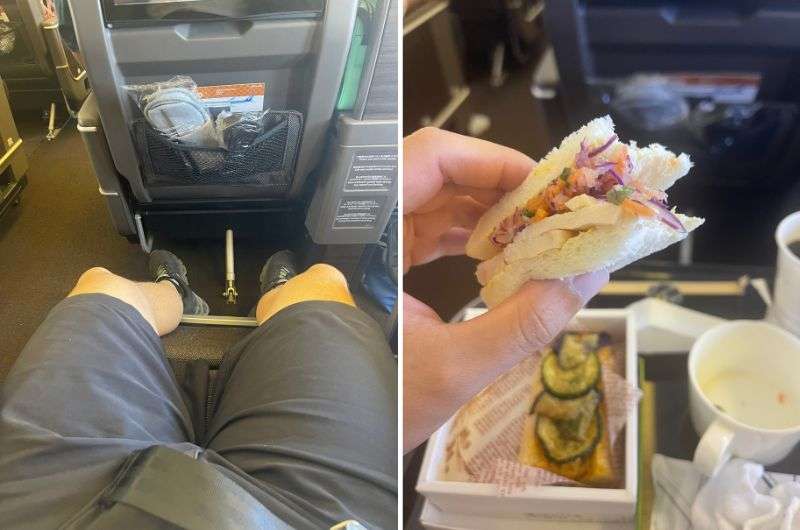
Flying in style. A glimpse into ANA's premium class on a domestic flight—extra legroom and a light yet delicious in-flight meal
Flying in style. A glimpse into ANA's premium class on a domestic flight—extra legroom and a light yet delicious in-flight meal
So, start looking for your passport, it’s time to fly! Let’s take an in-depth look at every aspect of flying in this bad boy of a chronological first-time flyer guide!
And once you’re actually there, you’ll be like “Oh yeah, this is what Jan talked about in his article!” and “I did it, I’m so glad I read that Next Level article and didn’t have a meltdown at the x-ray machines!”. Are you excited yet? I am, and I’m not even the one flying for the first time!
Advice for first-time flyers: Before your flight
As they say: “fortune favors the prepared,” so let’s set you up for success, shall we?

For people who hate being out of their comfort zone, the entire travel experience might be stressful. But hopefully, you’re that type where the nerves turn into excitement the moment you step off the plane
1. Your passport needs to be valid for at least 6 months after your travel dates (sometimes)
Make sure your passport is valid for 6 months after your travel dates. Many countries have this requirement, though not all of them—some are fine with just 3 months, and some don’t care as long as your passport covers your travel dates. Just remember the golden rule is 6 months and get it renewed if it’s nearing expiration.
I have an entire article about travel documents (visas, passports, Schengen rules, insurance, etc.)—it’s a practical read for anyone traveling for the first time:
2. Always book your plane tickets directly with the airline
I use flight aggregators to get an overview of flight options and prices but then always book my plane tickets directly on the airline website. This way you get reliable service and a far greater chance of solving any unforeseen situations if they occur.
Airlines change flight times, delays happen, medical situations can change your plans... anything. If you book through an aggregator, you’re often on your own and sometimes even out of luck.
I want to stress that this can make or break your trip. If you book with the airline, there will always be a live person ready to assist you if you need it.
So, go ahead and look at skyscanner.com or booking.com and see what the offers are. Then, grab your plane ticket on the airline’s website. (I always use booking.com for my hotel reservations, and I love them. I recommend that you do the same, but for flights, I’m sticking to my guns.)
3. Reserve your seats asap so you don’t get separated from your travel buddy
Most airlines these days charge extra to book a specific seat on the plane. Pay for the seat reservation at the time you book your plane tickets—it’ll calm your mind knowing that you don’t need to worry about having your partner/parent/friend sitting 26 rows behind you. You’re on an airplane for the first time, so you’re probably nervous enough without feeling like you’re all alone while you’re at it.
So, start packing your bags, it’s time to fly! Let’s take an in-depth look at every aspect of flying in this bad boy of a chronological first-timers guide.
And once you’re there, you’ll be like “Oh yeah, this is what Jan talked about in his article!” and “I did it, I’m so glad I read that Next Level article and didn’t have a meltdown at the x-ray machines!”. Are you excited yet? I am, and I’m not even the one flying for the first time!
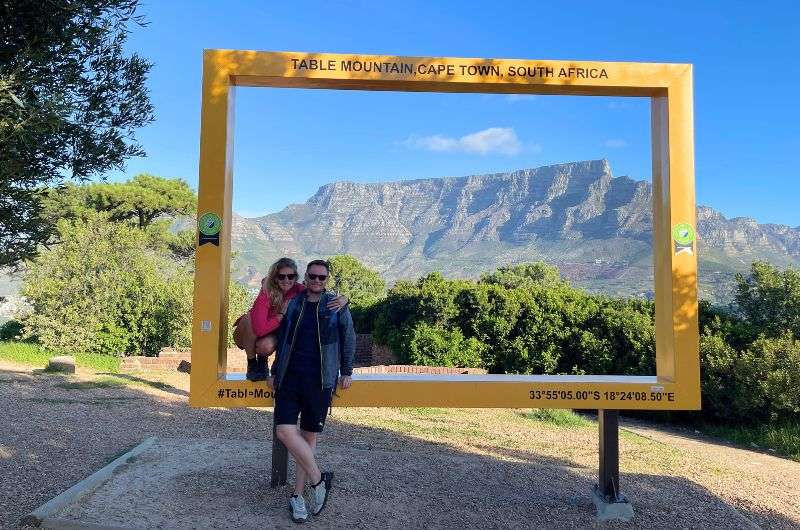
Paid for our bags in advance—so we could spend more in Cape Town, not at the airport
Pro tip: Even if you buy your tickets all together on one booking, if you aren’t paying for a seat reservation for everyone, you could end up sitting spread out all over the plane. They will use you and your kind to fill in those dreaded middle seats, too!
Another pro tip: If you’re prone to air sickness or think any little shake will set off a panic attack, steer clear of the back seats. The rear section of the plane is furthest from the wings, meaning that it can get slightly more movement in case of turbulence.
4. Pay for luggage when you buy your ticket, not at the airport
Don’t wait until you get to the airport to pay for your bags—you will pay WAY more that way. When you buy your plane ticket, you can choose the type and number of luggage you wish to take with you. It will be included either directly in your fare or as an add-on further in the booking process.
Pro tip: Once you are ready to pack, make sure to check luggage weight limits and size restrictions and stick to them. Otherwise, you’ll still have to pay extra (a LOT extra) at the airport. Sizes vary by airline, so always check your specific one!
5. Don’t put phones or laptops in your checked bags
Checked bags are the big ones that will go into the plane’s cargo hold. Do not put your laptop, phone, or anything else with lithium metal or lithium-ion batteries into your checked bags. It’s because if the battery happens to combust in the depth of the cargo hull, well, that would suck for everyone on the flight. Oh, and electronic cigarettes are also not allowed in there.
Otherwise, there aren’t many forbidden items that any sane person would need to worry about—obviously no weapons, poisons, fireworks, and such. Leave the live plants, animals, and food at home, too.
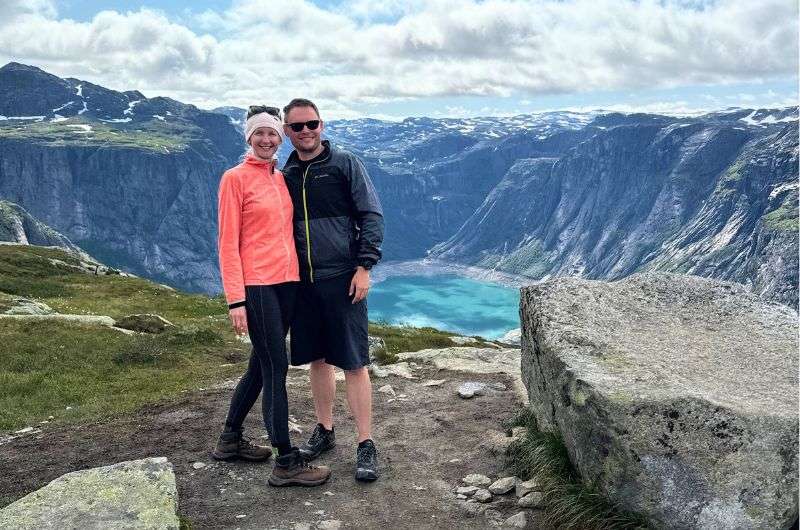
Conquered Trolltunga️ in Norway
6. Remember the 3-1-1 rule for liquids in your carry-on
Carry-on bags (aka hand luggage) are smaller bags or suitcases that come into the plane cabin with you. A lot of times, you can also carry a personal item in addition to your carry-on—a purse or a laptop bag, sometimes even a small backpack. They will check the contents of your carry-on and personal item at airport security.
Liquids have been a highly suspicious carry-on item ever since some idiot tried to blow up a plane with liquid explosives.
Nowadays, all of your liquids have to be in max. 100 ml (3.4 oz) containers and all of your containers must fit into a single 1-liter (1 quart) bag. Each passenger has an allowance of 1 of these bags, which is why this is called the 3-1-1 rule.
Your bag needs to be clear and will be looked at separately by security agents, so have it handy for the security check at the airport.
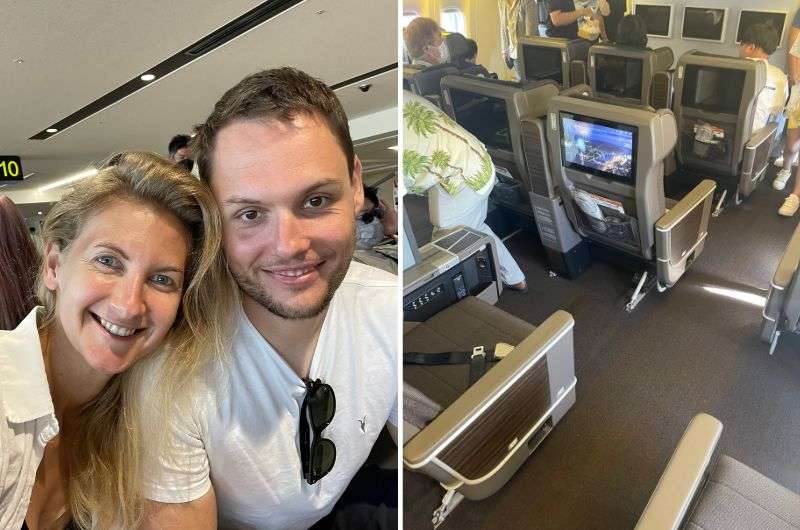
From one of our flights in Japan—ANA Premium Class domestic flight to Okinawa
Here are some more of my liquid tips:
- Toothpaste and makeup, such as mascara and liquid concealer, are all considered liquids. And in the United States, even powders are judged the same way as liquids. Perfumes and aerosols are also liquids.
- You cannot take half a bottle of shampoo and say there’s only 100 ml in there. Whatever the original bottle amount is, it is what is being judged.
Your water bottle needs to be empty, too. Just fill it up after security, lots of airports have drinking fountains.

POV: Enjoying a beer by the river before realizing it's over 100 ml and wouldn't make it past airport security @ Machu Picchu
Pro tip: If you have young kids, there are some exceptions to the liquid rules because apparently, children need to eat and drink despite carry-on rules.
See my 20 tips for packing a carry-on for the full rundown of prohibited items, the rules on packing medication, and other exhilarating packing hacks. Fun fact: Even toy guns, and even those that are very obviously colorful and plastic (like Nerf), are prohibited—I know because I’ve seen a kid cry about it IRL. But real knives and scissors with a blade up to 6 cm/2.3 in are ok.

There’s also often a bin where you can dump out your water bottle before security (not always though, so you may need to chug it or make a quick run to the restroom)
7. Download your airline’s app and check in online
All airlines have an app you can download. Get it. Find your plane ticket on it. This is where you’ll be able to check in online (usually a few days before your flight), and where your digital boarding pass will be stored. It’s also where you’ll be able to see your terminal and gate number on the day of your flight. It’s a handy tool where you can see all up-to-date information about your flight.
Pro tip: If you check in online but have checked bags, look for your airline’s baggage drop area at the airport (near the check-in desks). No need to stand in the check-in line if you already have your boarding pass.
First time at the airport: step-by-step guide for navigating airports

Business class perks = extra sleep before landing in Chile... Glad I didn’t stress at the airport—arrived just in time, no runway-watching needed @ Air France’s Business Class on my way to Chile
In this section, I will prepare you to go through every step at the airport. Here is the order in which you’ll do things (at every airport, everywhere):
- Find departures at your terminal
- Check in for your flight at the check-in desk and leave your checked bags
- Go through airport security
- Find your gate and board the plane
8. Don’t get to the airport more than 2–3 hours before your flight
Plan on arriving at the airport 1.5–2 hours before a domestic flight and 2.5–3 hours before an international flight.* There’s no need to be there earlier unless you think you’ll love staring out onto the runway for extended periods while you wait to board.
- Check-in counters usually open 2–3 hours before the scheduled flight time anyway, so there’s no use standing around for much longer than that.
- Head straight to check-in once you arrive, you can have coffee when you make it past security.
- If you are flying anything better than economy class, you’ll have your check-in desk, which means your line will be significantly shorter, and you can get to the airport even later.
- But don’t push it; check-in often closes an hour before departure time.
- Traffic, an accident, or a flat tire can make you want to pull your hair out even on a regular day, let alone when it has the power to ruin your first time flying. Allow plenty of time for the drive to the airport.
- Depending on the type of commute you have to the airport and the availability of parking at your particular airport, some commuters elect to forgo driving themselves and hire an airport driving service to drop them off directly at their terminal without the hassle of driving there, finding parking, and navigating your way from the car park to the terminal.
*There are a few popular airports that are notorious for their slow or complicated check-in and security. It makes sense to get there 3.5–4 hours before an international flight. These include: London Heathrow (LHR), New York JFK (JFK), Los Angeles (LAX), Paris Charles de Gaulle (CDG), Istanbul Airport (IST).
9. You can find your terminal on your plane ticket or in the airline app
Many airports have more than one terminal, and you’ll need to know which one your flight leaves from beforehand, so you know which one to head to. The terminal is an airport building that planes arrive and depart from.
- Every terminal has a departure area and an arrival area—make your way to departures. In smaller airports, there will only be one area for everyone.
- Each airport is different. Sometimes, you can walk between terminals, sometimes you need to use trains or buses, so it’s important to not just head into a random one if you don’t want to be running around excessively.

Take your sense of direction with you, you'll need it even outside the airport... like getting to the Cape of Good Hope in South Africa
When you enter the departure hall, you’ll see screens that list departing and arriving flights. They list flight numbers, destinations, departure/arrival times, the check-in counter number, and the gate number. There will also be a note at the end stating the status of the flight, like “check-in open”, “go to gate”, or “boarding” (better hope it doesn’t say that yet though).
10. Your checked bags will be weighed at check-in
The check-in counters are where you’ll let the airline know you’ve shown up for your flight. You’ll show your travel documents, be assigned seats (if you haven’t reserved them online already), get your boarding pass, and leave your checked bags.
It’s also where your bags will be weighed. The standard weight limit for checked baggage is 23 kg (50 lbs) per bag in Economy Class and 32 kg (70 lbs) per bag in Business Class and higher.
This is where the folks that ignored weight limits need to pay the overweight fee or open their suitcases, right there in front of everyone, and try to wear as many jackets as they can to cut some weight from their bag. It’s not fun, it happens all the time, and it’s certainly a great way to escalate your first-time-flyer stress. So, don’t overpack!

Either pay extra for overweight bags or get creative...
Lines at check-in, especially on international flights at large airports, can be MASSIVE. This is why you want to check in asap after you get to the airport and leave the coffee break for later.
Note: If you don’t have checked luggage and have checked in online beforehand, you will skip check-in. You already have your boarding pass in your phone (or, if you’re particularly ancient, probably printed out), so you’re good to head straight to security.

Check-in counters at an airport. Prepare your tickets and other travel documents depending on where you are going
11. Go through airport security as soon as you can—the lines can be very long
There is often a longish to very long line to get through airport security, so get it over with as soon as you can. It’s also where you’ll feel the most like you may be wrongfully detained and sent to a tiny dark cell because your passport photo is weird and your nail clippers are too sharp.
Only traveling people (with valid boarding passes) and flight crew are allowed past security. Security is the border between landside and airside where you and your bags will go through x-ray machines to check that you’re not carrying anything illegal on or inside the bags or your body.
12. Pack things so they’re easy to take out of your carry-on at security check
Next, you’ll need to put your bags and some of your personal items into the bins that are waiting at the conveyor belt at the x-ray machines. Keep this in mind when packing your carry-on so it’s easy for you to take sh*t out and shove it back into your bag moments later.
I am a man, so I barely pack anything and fly through. My girlfriend though, she ends up juggling baggies of cosmetics, her headphones, her sweatshirt, her purse, and passport in one hand while she’s trying to dig out that lip gloss she forgot in her carry-on side pocket with the other.
To make sure you’re not sent back to x-ray more stuff over and over again, be prepared. These items go into the bins without anyone having to ask you:
- Your laptop
- Your 1-liter clear baggy of liquids (check the 3-1-1 rule above)
- Any medication, empty bottles, and knives/scissors
- Any “extra” or baggy outer clothing, like your jacket and sweatshirt or scarf
- Your hat
- Your shoes only if you’re wearing big boots or platform shoes (anything that could serve as a hiding spot for drugs)
- Your watch
- Your belt
- Everything that’s in your pockets
Once you strip yourself of every conceivable threat, send the bins off into the X-ray machine and wait your turn to walk through the scanner (usually a “backscatter passenger scanner”, but I still call it the X-ray machine).
Finally, walk through the machine when the security agent motions you to (one by one, no walking with your wife and kids).
Religious considerations
If you can’t take off your [fill in the item of clothing that you wear to appease whichever deity you follow] at security, you can ask—or will be asked—to go to a dedicated private area and deal with it there. A Muslim woman, for example, can ask to only be seen by a female security officer in this case. But no, you can’t take your “religious” knife or sword with you on board.
13. If you are deemed suspicious, stay calm and follow instructions
If you get stopped by the security person at the x-ray machine, don’t panic, you probably just got chosen for a random extra check. It’s no big deal and it happens all the time, you aren’t going straight to a jail cell.
The agents have dozens of behaviors they look out for that could be deemed suspicious, like yawning too much or staring at the ground. So, if you partied too hard last night or are stressed because this is your first time at an airport, you may be selected.

The airport respects different religions, but only up to a certain security level. Here I am at the Wailing Wall in Israel
Your bags get scanned and come out at the other end in the same bins you put them into. Just take your stuff and you’re free to go unless you see another security person take your bag to the side.
If you get called over for explanations, remember they can’t just search your bag themselves, so you will be asked to open your own bag and show the contents. It’s either nothing and you can go repack your bag (my girlfriend “loves” when that happens), or they found that 120 ml hairspray you tried to hide and will confiscate it from you.
Storytime: My friend has a fantastic story about a “sex toy” that security was trying to have them take out of their bag because apparently that is (was?) a big no-no in Vietnam. The item in question was an electric shaver, and the security agent couldn’t for the life of him pronounce “sex toy” in a way that my friend would understand, especially since he wasn’t carrying anything of the sort. Anyway, the security person was frustrated and very embarrassed by the numerous attempts he was trying to explain what he was looking for in bad English.
14. Get to your gate at least 40 minutes before your scheduled flight time
A gate is the area in the terminal where you board your airplane. Each scheduled flight leaves from one gate, and all the passengers of that flight gather there while they are waiting to board. There are seats, info screens, a counter (wo)manned by personnel from your airline, and the magic doorway that leads to your aircraft.
So, after you clear security, stuff all your stuff back into your carry-on and look up at the information screens once again. Locate your flight and find your gate number. Especially at large airports, you’ll want to start walking in the direction of your gate, because they can be VERY far apart.

Relaxing at 35,000 feet because I didn’t have to sprint to my gate... Got there 40 minutes early, no last-minute Olympic speedwalking required.
At this point, airports resemble shopping malls, with tons of stores and extremely overpriced restaurants and cafes ready to take your money while you wait for your departure time. This is when you can have your coffee break. Look at you, you’re killing it! Flying for the first time like a pro!
You want to be at your gate no later than 30–45 minutes before your scheduled departure time because the boarding process takes a minute, and this is roughly when they start calling passengers in. Shorter flights will start boarding later than long-haul international flights.
Pro tip: If you aren’t at your gate before boarding is closed, even if it’s still before your departure time, you will be denied access to the plane. Once that door is shut, you are out of luck.
15. Listen to announcements so you know when to board
Once the plane is ready for boarding, the gate personnel will announce it via the speaker system, and it will also show on the info screens. People will start lining up and then, when you reach the counter, be ready to show your passport and boarding pass.
Once you are cleared, you’re finally boarding your plane! Just follow the crowd, you can’t get lost at this point, because you’re usually in the air bridge, aka boarding bridge, sky bridge… and it’s not a bridge at all—it’s a tunnel that connects the terminal straight to the airplane door.
Pro tip: International flights often board by sections of the plane, so know your seat row number (it’s on your boarding pass) and listen up—they’ll be calling out the numbers as they are ready for them. Priority boarding passengers will be called first, as will people with disabilities and children.
16. Sometimes, there’s a bus instead of a sky bridge
Sometimes, you will notice the absence of a sky bridge at the gate. Not to worry, this just means you will be getting on a bus that’ll take you to your airplane instead (or, in some cases, you’ll walk to the plane).
Not gonna lie, it’s annoying as heck, because a 30-second walk to the airplane door can turn into a 20-minute wait on a crowded airport bus while it waits for everyone to get their boarding passes and passports checked, and then it takes a 1-minute trip to the airplane.
In Europe, this is often the case at smaller airports or if you’re taking a low-cost airline, but in the US, you’ll get the dreaded bus almost always at airports like Washington DC and Las Vegas.

When I see this thing waiting for me, I almost want to turn around and run away
As you walk towards the plane through the boarding bridge, you may start to feel all kinds of jitters: nerves, but also excitement. You’ll be way off the ground in a matter of minutes!
17. Your flight attendants will greet you at the airplane door
Your flight attendants will be greeting you at the airplane door as you walk in. Just say hello and keep moving. They will also help usher you into the correct class or aisle if you’re on a larger aircraft—have your boarding pass handy.
18. Find your seat and store your carry-on right away
To find your seat, keep scooting forward while looking at the aisle and seat numbers printed on the bottom of the overhead storage bins. Once you find your spot, you can either shout “Heureka!” and start chatting with your travel companion about who gets the window seat, OR, you can store your carry-on bag in the overhead bin and get the heck out of the way so you’re not holding up the entire line.
You can keep your purse or laptop with you at your seat—it will need to be shoved under the seat in front of you for take-off and landing.
First time on an airplane: written and unwritten rules on the plane

Better airlines will have better quality seats, food, and entertainment
Economy too crowded for your taste? You may want to look into Premium Economy:
While your plane is on the ground, you just need to fasten your seatbelts and chill—you’ve done everything you needed as a first-time flyer, and now it’s in the hands of the pilots and crew. For now, don’t recline your seat or take down the tray table.
19. The different phases of a flight: you’ll be less stressed if you know what happens when
When everybody is on board, doors close and you are now required to sit in your seat with your seat belts fastened until you reach cruising altitude. What is that? Here are the phases of a flight and the specifics that interest you as the passenger:
- Eventually, your plane will start taxiing—driving around the airport like a winged bus, moving from the terminal to the runway. The flight attendants will still be moving around the plane, checking that everyone has seatbelts fastened, seats in the upright position, and bags stored. They will also perform a pre-flight safety demonstration at this time.
- Once you’re cleared for takeoff, the plane revs its engines and starts quickly gaining speed to be able to lift its massive metal body full of hundreds of tourists and their overfilled luggage off the ground. This will be loud and the force of acceleration will push your back into the seat a little. If you like rollercoasters, this flight phase will be fun. If not… well, takeoff only takes 30 seconds.
- The airplane climbs up to a certain altitude (about 10 km or 35,000 ft) before it can stay put and just fly level. A climb will usually include turning to adjust the flight path, which means one wing gets lowered while the other goes up high—I recommend trying to keep your eyes on the Earth in these bits to prevent dizziness and air sickness. Nobody is allowed out of their seats in this phase. Your ears may feel funny due to pressure changes—chewing gum or yawning should pop them and make them feel ok again.
Now you’re cruising—flying at a steady altitude, basically going straight with nothing too exciting happening, unless you watch an action movie. The seatbelt sign will turn off and fun stuff like snacks will start appearing at your seat. You can walk around and use the toilet in this phase. It’s also the part where I imagine the pilots get their coffee, switch on auto-pilot, and just sit back and chill (with one eye on all those gauges at all times, of course).
- When you’re approaching your destination, your plane will start to descend. It’s the opposite of the climbing phase. The pressure changes again, you’ll likely fly down through the clouds, and everyone will need to stay in their seats from now until forever. If you need a bathroom break, make sure to go while you’re still cruising! Closer to the ground, you’ll hear a strange noise that may sound like something just fell off the plane—no worries, it’s just the landing gear coming out.
- Landing is the last phase of a flight. Hopefully, it’ll be a soft one, but there will almost certainly be some kind of small jolt when the wheels touch the ground—it’s normal. Once the plane is on the ground, you’ll hear the loud noise coming from the engines—you’re not taking off again, it’s just the reverse thrust helping the plane slow down faster. Stay seated during taxiing, it’ll take a few minutes until you are allowed to stand up and even more minutes before your plane is ready to let you off again.

Almost there!
20. It is normal to be scared of flying for the first time—accept it and breathe
Some people are scared of flying on every single flight, not just on the first one. I regularly see people turn white as chalk, clutching their armrests at landing.
But I say why go through the anxiety of imagining yourself crashing to the ground (I assume that’s what you’re afraid of) when you can spend hours eating free food, watching movies, reading that book you’ve been putting off, and being able to do nothing but relax?
And while I understand there’s not a switch that you can flip to turn off your fears, there are steps you can take to minimize them. Here are Dr. Jan’s Five Fearless Flying Facks (like FAQs and hacks together, get it?)!
- Separate fear from danger. The fact that you’re scared shitless isn’t affecting the actual safety of flying. You are just as safe as the couple giggling at a romantic comedy two rows down. So be like them. The danger is what it is—tiny!—no matter what your amygdala is telling you. Deep breaths.
- Knowledge is power. Read up on how airplanes work instead of asking “But how can such a huge, heavy thing stay in the air?!” a million times. It can, it does, and it’s not just by chance. Flying is the safest mode of transportation—the chances something will happen are minuscule. See safety statistics. A few starter statistics: At any given moment, about half a million people are in the air on a commercial flight. Some 100,000 flights take off around the world every single day. There were 5 fatal accidents among 32.2 million flights in 2022, and only 1 of those was a jet aircraft (the others were propeller planes). Plus, technology and safety features are getting better every year. See airline safety ratings to look at your airline and ease your mind.
- Expect bumps along the way. Having realistic expectations is one thing that can greatly help you not become nervous when things like turbulence hit. Read up on how turbulence is only dangerous in terms of bags flying out of overhead bins, or you spilling your drink on your neighbor, but your plane is built to withstand wind. It’s literally made to fly in the sky, through clouds, in the rain, and yes, even in the wind. It’s not fun, but it’s not going to make the wings snap off, ok? The seatbelt sign comes on not because the plane is in danger of falling, it’s because you’re in danger of falling on the way to the toilet.
- Learn to help yourself. Do you take deep breaths? Count to 100? Close your eyes and imagine yourself on a tropical beach. Talk up a storm? Whatever you need to do to calm yourself down in regular life, be prepared to implement it on your (first) flight, too. And remember, sometimes you need to be strict with yourself. When your imagination starts running wild, just cut those thoughts right off and tell yourself “NO! This does not serve me, I don’t need it, pass the peanuts please.”
21. Know when it’s safe to use your phone and laptop
Sure, you can use your phone on the plane, just not for calling... I guess you could use the calculator? Your phone needs to be in “airplane mode”, which turns off all signals coming and going from the phone (so they don’t interfere with all the signals coming and going from the airplane).
You can turn on wifi to connect to the plane’s wifi if it’s offered by your airline—just be ready for the prices to be insane.
Laptops have to be in an offline mode and cannot be used at all during takeoff and landing.
22. You can take your own snacks, but…
You can take food on a plane, just make sure it’s not stinky because your plane mates will hate you! Beware that some foods will qualify as a liquid and will need to adhere to the liquid limits (3-1-1 rule—see above). Cream cheese, spreads, apple sauce, Nutella, all of them will need to be tiny in order to be allowed on your flight.
23. There’s a reason airplane food tastes bad

The food is not always that bad if you fly with a quality service! My tip: Austrian Airlines Premium Economy Class
Airplane food gets a bad rap, but it’s not entirely its own fault. Fun fact of the day: Because of the cabin pressure and low humidity, we lose around 30% of our taste buds when we’re on an airplane. Less taste means less satisfactory food! Airplane catering companies will try to compensate for this indisposition by adding extra salt and extra sugar and god knows what else, so if you do like your airplane food, this may be why.
24. Don’t expect good coffee on a plane, but it’s probably safe
Have you heard of this airplane travel tip?! Isn’t having coffee on the plane part of the fun? It’s usually explained that the water for the coffee (the same thing with tea) is from the plane’s water tank and there is some concern about how clean and bacteria-free those tanks are. Notice how you never get tap water on a plane? Yeah.
Well, just to ease your mind, the water tanks on planes do get cleaned at least annually, and the water is tested periodically for bacteria. And, at the very least, remember that most bacteria is killed at 76°C (170°F), so you should be safe if you’re having a hot beverage. The fact that the taste will likely be horrible is another thing, but that’s just down to bad coffee bought in bulk.
The one thing I would maybe consider is if you are on a plane from a country where the tap water isn’t safe in the first place, you may want to steer clear of it on the plane as well.

Namibia’s animals are simply amazing. The tap water... not so much. It’s not crazy bad, but maybe skip the airplane coffee on the flight home if your stomach is on the sensitive side
25. Going to the toilet on an airplane is just like going to a regular toilet
I don’t know if this is even a concern for anyone, but just to mention every last detail, yes, there are toilets (called lavatories) on airplanes. It’s a teeny tiny room, but it gets the job done.
If you’re using it for the first time, you will likely get startled when you flush—it sounds like you will get sucked in and spat outside of the plane. So, I recommend closing the toilet before flushing. To be safe.

The whole plane is sure I was in the bathroom...
Toilet myths: No, toilet waste doesn’t get sprayed out of the plane when you flush! I’ve heard this myth and I can’t fathom it. It’s not like it would disintegrate, so what’s the alternative? “Oh look, it’s a plane! Get your umbrellas!”?? There’s a tank on the plane, ok?
Airport guide for first-time flyers: What happens after landing?
You aren’t quite done with your first flying experience even after the plane lands. Getting out of the airplane is one thing you’ll need to do—trust me, those minutes waiting for the crew to open the plane doors can feel like hours following a long flight!
And then you still have to pick up your bags and get through immigration. But no worries, it’s pretty straightforward.

Grab your stuff, it’s time to pick up your rental car! Here I am with this beast in Peru
26. “Immigration” is where you cross the border
The first thing you’ll want to do once you leave the plane (besides maybe finding a restroom), is go through immigration, which is border control. There will be a line forming as you leave the baggage claim area. Depending on the country you’re traveling to, there may even be more lines, so pay attention to where you’re queuing—sometimes there’s a separate line for residents and another for 3rd country nationals.
When you see the line forming, you’ll understand why some people are very antsy once the plane lands and try to get off asap. It’s because they hate immigration lines, and clearing immigration can take as long as 30–90 minutes in some countries. Higher cabin class won’t get you any benefits here.
You’ll show your passport, provide any other required travel documents, and, in places like the United States, answer questions that make you feel like you’re there to overthrow the government. Then you’ll get stamped in and you’re officially in your destination country! Congrats!
Some countries require a visa on arrival, so look around for a counter that issues those first if that’s the case.
After immigration, you may also see a customs area. Mostly you just pass it or go through the side that says “Nothing to declare”. Customs is where you have to go declare things like millions of dollars in cash, a suitcase full of cigarettes, or raw meat that you’re bringing into the country (just a warning—don't try to do either).
It’s where they’ll ask you to open your luggage in case the airport scanners catch something they didn’t like, and you can be asked to remove things from your bag before they let you continue on your vacation. They’ll also fine you if you’re transporting forbidden goods, so read up on the regulations of your destination country beforehand.
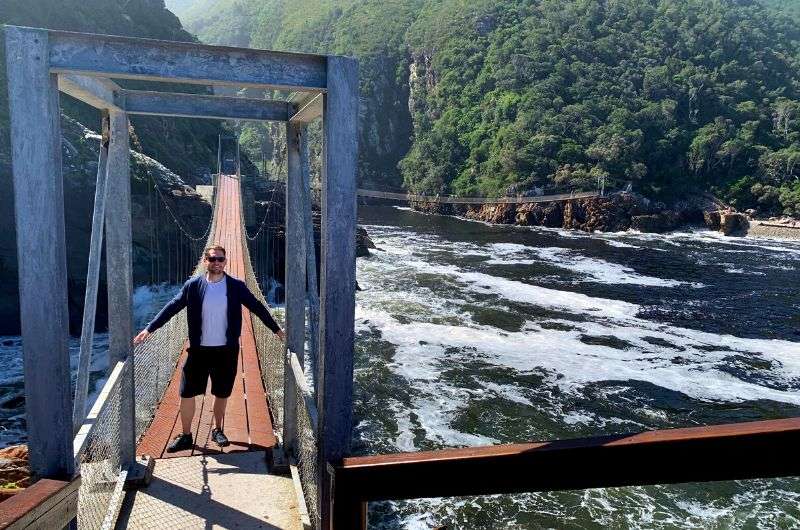
Made it through immigration—no millions in cash or suitcase full of raw meat️ @ Storms River in South Africa
27. Your last stop is baggage claim: look for your flight number
Finally, head to the carousels where you’ll pick up your luggage. Follow the signs to “baggage claim” or some similar wording. If you can’t see it, just follow the signs to “Immigration” or “Exit”. Most airports are built in a way where you can’t wander off without your stuff, so this should be the easy part.
It takes a while for the strong men who mishandle luggage to get everyone’s bags and suitcases out from the cargo hold, so you’ll probably hang out for a while before the carousel starts moving. Oh, and you’ll need to find the right one first—there will be a screen with your flight number and departure airport by your carousel. If you’re premium economy or higher, your bags will likely come out first.
Then, all you need to do is look out for your bags and grab them off the conveyor belt. There are a few things to keep in mind:
- Always make sure that you grab your bag. Everyone has a black suitcase these days and they are all very similar. Check the tags (they will get put on your luggage at check-in).
- If you miss your bag as it goes past you, don’t panic and start pushing fellow passengers over trying to chase it. It won’t get eaten by the conveyor belt monster or anything, they keep bags twirling around on there for a while.
- If for some reason you get to baggage claim later, all the leftover bags get taken off and usually either just get left on the ground by the carousel or are taken to the lost luggage counter.
28. If you have a connecting flight, don’t go through immigration
Just a quick mention about layovers—if you have a connecting flight, you’ll go through the process of alighting the plane and making your way through the terminal, but not to baggage claim. You’ll just stay in the transfer area of the airport, moving to another gate, and starting the boarding process again when it’s time. There will be signs pointing you in the right direction (usually saying “connecting flights” or something similar).
If you have a long layover and you want to leave the airport while waiting, you theoretically can. You don’t worry about your bags until your final destination, but you do need to check entry requirements at your layover stop. Also, remember that many airports are very far from the city they serve, so it may not even make sense to try to leave the airport at all. Instead, go explore the airport and its restaurant and entertainment options.

Eating in Nagano, Japan (restaurants in Japan are surprisingly cheap!)
29. Decide on how you’re going to leave the airport
Now that you’ve cleared immigration, you’re good to go! Depending on what your mode of travel from the airport is, go do that. The easiest way is to take a taxi (I like using taxi apps) or by asking your hotel to send a taxi to get you.
There are always tons of taxi and car rental counters at the airport, but it’s a good idea to book your car in advance. Waiting until you get to the airport to figure out what transport means is a crazy and bad idea. And by bad I mean expensive and probably a rip-off. You don’t want to be dealing with the hawkers at the rental and taxi companies after hours of travel. Or ever, really.
And that’s it. Have a fantastic vacation, and when you’re ready to go home, you’ll be flying for the second time! This time, you’re one step closer to being a pro. You got this!
What is the best advice for nervous flyers?
Ironically, the most stressful part of flying is everything that happens before and after the flight. When you’re in your seat on the aircraft, you literally can’t do anything but sit back and relax while another human takes on the huge responsibility to get you to where you’re going.
It’s just like sitting in a cramped movie theater with free drinks and snacks and your (almost) personal assistant ready to cater to your every whim. (Unless you’re sitting in the back and want chicken—you’re getting pasta, I’ll tell you that right now.)
Remember this: Flying is safe and it’s easy peasy lemon squeezy—unless you have little kids. In that case, flying is stressful AF from the moment you decide you want to fly to the moment you get to your hotel. At least it’s still safe though.
People consider flying stressful because it’s not exactly a routine occurrence in normal life. You’re shipping yourself to another country, dealing with endless rules, requirements, and restrictions, getting checked over and over again by intimidating-looking men and women, making you feel like you are one of only a few non-criminals in a sea of traveling terrorists.
But then you board the plane and everyone is smiling their most professional smile and it’s just a matter of hours until you’re finally there, and all is well again.

Now the adventure can begin! This is me at the Beinn Eighe in Scotland



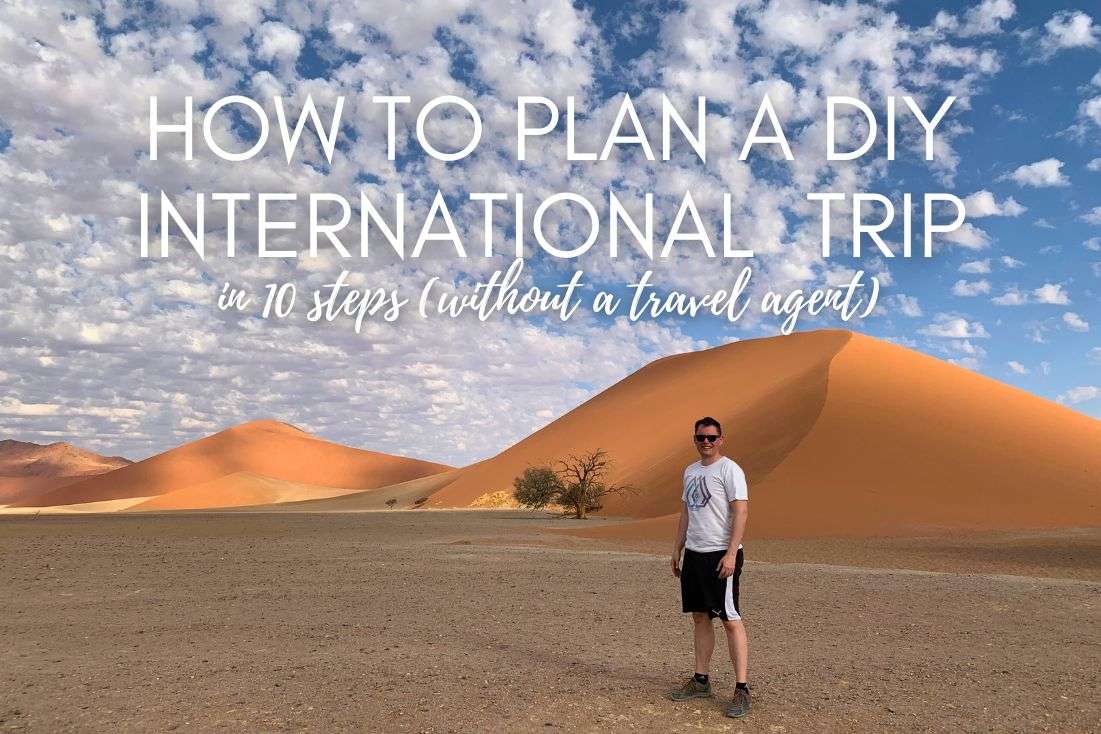






Comments | Thoughts? Give us a shout!